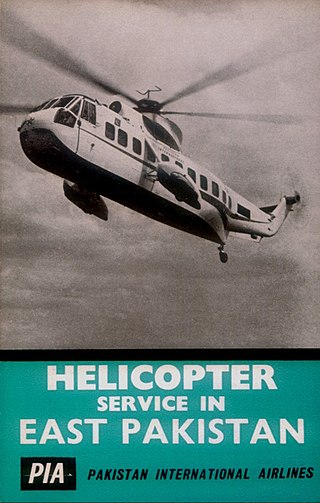
Eastern Air Lines Flight 401 was a scheduled flight from New York JFK to Miami. Shortly before midnight on December 29, 1972, the Lockheed L-1011-1 TriStar crashed into the Florida Everglades, causing 101 total fatalities. Three of the four cockpit crew members, two of the 10 flight attendants, and 96 of the 163 passengers were killed; 75 people survived.

Scandinavian Airlines System Flight 751 was a regularly scheduled Scandinavian Airlines passenger flight from Stockholm, Sweden, to Warsaw, Poland, via Copenhagen, Denmark. On 27 December 1991, a McDonnell Douglas MD-81 operating the flight, registration OY-KHO, piloted by Danish Captain Stefan G. Rasmussen (44) and Swedish first officer Ulf Cedermark (34), both experienced pilots with 8,000 and 3,000 flight hours, respectively, was forced to make an emergency landing in a field near Gottröra, Sweden. Ice had collected on the wings' inner roots before takeoff, broke off, and was ingested into the engines as the aircraft became airborne on takeoff, ultimately disabling both engines. All 129 passengers and crew aboard survived.
New York Airways was an American helicopter airline in the New York City area, founded in 1949 as a mail and cargo carrier. On 9 July 1953 it may have been the first scheduled helicopter airline to carry passengers in the United States, with headquarters at LaGuardia Airport. Although primarily a helicopter airline operator with scheduled passenger operations, New York Airways also flew fixed wing aircraft, such as the de Havilland Canada DHC-6 Twin Otter 19-passenger STOL twin turboprop aircraft.

Pakistan International Airlines Flight 688 was a domestic passenger flight from Multan to Islamabad with a stopover in Lahore, operated by Pakistan's flag carrier Pakistan International Airlines. On 10 July 2006, the aircraft operating the route, a Fokker F27, crashed into a mango garden after one of its two engines failed shortly after takeoff from Multan International Airport. All 41 passengers and four crewmembers on board were killed.

The history of aviation in Bangladesh began with kites, the traditional heavier-than-air man-made object that is flown by one or more people while staying on the ground. The first recorded manned flight was arranged by the Dhaka Nawab Family in 1882, which resulted in the death of the flyer.

The Sikorsky S-61L and S-61N are civil variants of the SH-3 Sea King military helicopter. It was developed and produced by the American helicopter manufacturer Sikorsky Aircraft.

Aeroflot Flight 411 was an international scheduled flight from Sheremetyevo Airport, Moscow to Freetown, Sierra Leone via Dakar in Senegal. Early on 6 July 1982, the four-engined Ilyushin Il-62 crashed and was destroyed by fire after two engines were shut down shortly after take-off. All 90 passengers and crew on board died as a result of the crash.

On 6 November 1986, a Boeing-Vertol Model 234LR Chinook helicopter returning workers from the Brent oilfield crashed on approach to land at Sumburgh Airport in the Shetland Islands. At 2.5 mi (4.0 km) from the runway the helicopter had a catastrophic forward transmission failure which caused the tandem rotor blades to collide. The helicopter crashed into the sea and sank. Forty-three passengers and two crew members were killed in the crash; one passenger and one crew member survived with injuries.

G-BEID was a Sikorsky S-61N helicopter of British International Helicopters which made a controlled ditching in the sea 29 nmi northeast of Sumburgh on 13 July 1988 following an engine fire. There were no fatalities.

Cougar Helicopters Flight 91 was a scheduled flight of a Cougar Sikorsky S-92A which ditched on 12 March 2009 en route to the SeaRose FPSO in the White Rose oil field and Hibernia Platform in the Hibernia oilfield off the coast of Newfoundland 55 kilometres (34 mi) east-southeast of St. John's, Newfoundland. Of the eighteen aboard, only one survived.

South African Airlink Flight 8911 was a positioning flight from Durban International Airport to Pietermaritzburg Airport, South Africa, that crashed into the grounds of Merebank Secondary School, Durban shortly after take-off on 24 September 2009, injuring the three occupants of the aircraft and one on the ground. The captain of the flight subsequently died of his injuries on 7 October 2009.
Several aviation incidents and accidents have occurred in which the control surfaces of an aircraft became disabled, often due to failure of hydraulic systems or the flight control system. Other incidents have occurred where controls were not functioning correctly prior to take-off, either due to maintenance or pilot error, and controls can become inoperative from extreme weather conditions. Aircraft are not designed to be flown in such circumstances; however, a small number of pilots have had some success in flying and landing aircraft with disabled controls.

Qantas Flight 32 was a regularly scheduled passenger flight from London to Sydney via Singapore. On 4 November 2010, the aircraft operating the route, an Airbus A380, suffered an uncontained failure in one of its four Rolls-Royce Trent 900 engines. The failure occurred over the Riau Islands, Indonesia, four minutes after takeoff from Singapore Changi Airport. After holding for almost two hours to assess the situation, the aircraft made a successful emergency landing at Changi. No injuries occurred to the passengers, crew, or people on the ground, despite debris from the aircraft falling onto houses in Batam.

Aeroflot Flight 2306 was a scheduled domestic passenger flight from Vorkuta to Moscow in the Soviet Union, with a stopover in Syktyvkar. The Tupolev Tu-134 operated by Aeroflot crashed on 2 July 1986 during an emergency landing after it departed Syktyvkar, killing 54 of 92 passengers and crew on board.

On 15 March 2005, a Britten-Norman Islander air ambulance, operated by Loganair, crashed off the coast of Scotland, killing both people on board.

Pakistan International Airlines Flight 661 was a Pakistani domestic passenger flight from Chitral to Islamabad, operated by Pakistan's flag carrier Pakistan International Airlines. On 7 December 2016, the aircraft serving the route, an ATR 42-500 twin-turboprop, lost control and crashed near Havelian following an engine failure. All 47 people on board died, including singer-turned-preacher and entrepreneur Junaid Jamshed, and the Deputy Commissioner of the District of Chitral.

The East Pakistan Helicopter Service refers to the scheduled helicopter services operated by Pakistan International Airlines (PIA) in East Pakistan during the 1960s. It was one of the earliest air services of its kind in the world and one of the most extensive helicopter networks in history.

Pakistan International Airlines Flight 8303 was a scheduled domestic flight from Allama Iqbal International Airport in Lahore to Jinnah International Airport in Karachi, Pakistan. On 22 May 2020, the Airbus A320 crashed into Model Colony, a densely populated residential area of Karachi only a few kilometres (miles) from the runway, while on a second approach after a failed landing with landing gear not deployed. Of the 91 passengers and 8 crew on board the aircraft, 97 were killed, and two passengers survived with injuries. Eight people on the ground were also injured in the accident, one of whom later succumbed to her injuries.

Northwest Orient Airlines Flight 324 was a military charter flight from Haneda Airport to McChord Air Force Base. On the morning of January 19, 1952, the flight crashed into Hecate Strait in British Columbia, Canada, while making an emergency landing at Sandspit Airport. All three crew members and 33 of the 40 passengers were killed, making the flight the third-deadliest aviation accident in Canada at the time.

















